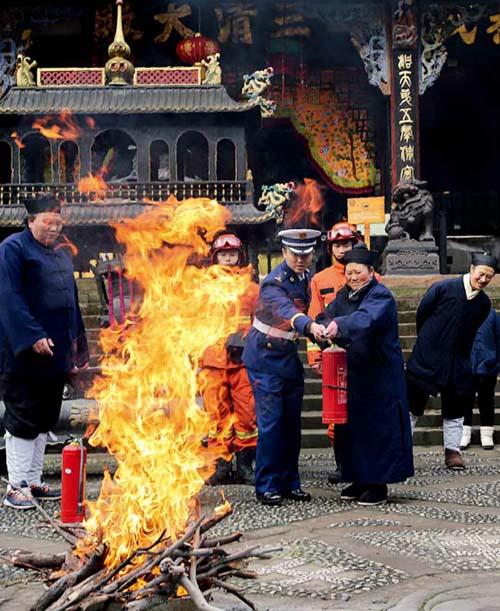Mountain Heroes
by Ru Yuan
On the first day of 2019, 31-year-old Tang Tianjun and his teammates from the No. 1 squadron of the Chengdu forest fire services division buttoned up their uniforms and headed to Qingcheng Mountain to perform rounds. About 70 kilometers from Chengdu, capital of Sichuan Province, lies Qingcheng Mountain, a UNESCO World Heritage site known as one of the birthplaces of Taoism and a key area for fire prevention.
This year marks the 14th year that Tangs squadron has carried out fire prevention duties in the forested areas of Qingcheng Mountain. The team is also responsible for protecting nearby areas including the Dujiangyan scenic spot, known for its time-honored irrigation and flood control project constructed around 256 B.C. that is still in use today.
A typical day for firefighters on Qingcheng Mountain starts quite early. A morning briefing on the overall fire strategy for the region is held before firefighters head off to different areas to patrol. After the briefing, personnel are dispatched to their respective areas, fully outfitted with firefighting equipment. Qingcheng Mountain is home to more than 30 peaks, with the tallest, Laojunge, being nearly 1,300 meters high. It makes patrolling no easy task. During holidays, especially major Chinese festivals when tons of people stream into the Taoist temples on the mountainside to burn incenses and pray for good luck, work becomes even heavier.
Another part of fire prevention work on Qingcheng Mountain involves the popularization of fire prevention knowledge among both employees of the scenic spot and Taoist priests. “You wouldnt believe that many Taoist priests are actually quick learners on how to use fire extinguishers,” grinned Tang. “And they are obviously good students when it comes to protecting their temples from fires.” Tang and his teammates frequently share information about fires, safety and how to respond to emergency situations. They disseminate fire prevention knowledge to every group in the community.
After fighting fires for more than 10 years, this year is a bit different for Tang and his teammates. On December 26, 2018, they switched out their former olive-green uniforms for new blue ones. More importantly, alongside fire prevention and firefighting, their workload now includes more rescue efforts.
The change came as a result of Chinas ongoing reform of its firefighting system. In March 2018, a plan on institutional restructuring of Chinas State Council resulted in the establishment of the Ministry of Emergency Management. Incorporating functions of many former ministerial-level agencies, the new ministry is responsible for compiling and implementing emergency management plans as well as organizing rescue and relief for disasters and workplace accidents. It also oversees comprehensive management of the fire and rescue service. Chinas firefighters, who previously were part of the military, became fire and rescue teams under the new ministry.
For Tang and his colleagues, the change required them to receive further training and become more professional. Now the team not only rescue victims from fires, but also from many other hazardous conditions such as automobile crashes and collapsed structures. They need to provide incident stabilization for forest fires, floods and hazardous material releases, just to name a few, and work quickly to reduce dangers and minimize damage.
To prepare for the new situation, Tang and his teammates now receive daily systematic and rigorous training. They learn and practice skills after their daytime duties. While professionalization of firefighting has long been standard in the United States and some European countries, China started late. “We need to work fast to catch up with them,” asserted Tang. “We will try our best to save lives as well as minimize damage to property and the environment.”
